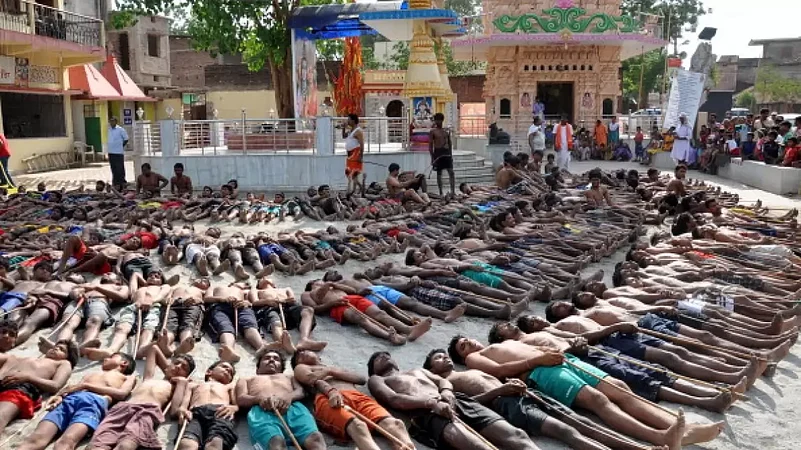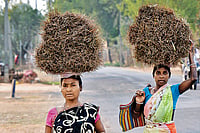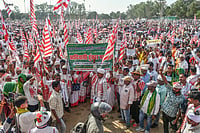For Gautam Kumar, two consecutive years of drought in Jharkhand have been nothing short of a catastrophe. For someone whose entire household relies on agriculture, even a single drought brings disaster. This year (2023), 159 blocks in 17 districts of Jharkhand have been declared drought-affected, the Gidhaur block in the Chatra district is one of them.
Fifteen kilometres from the Chatra district headquarters is the village, also called Gidhaur, where Kumar has three acres of agricultural land. The 32-year-old tells Outlook, “In 2021, we were able to keep three quintals of our paddy crop for consumption and sell off 12 quintals. But in 2022, the total yield was not even a single bag (50 kg). What was sown remained in the field. And this time (2023), because we irrigated the fields, we got seven bags somehow. We pray that there is enough food to last the year.”
In 2022, the farmers of Jharkhand faced their most severe drought since the formation of the state. After several surveys and studies, the government declared 226 blocks in 22 of the 24 districts of the state drought-hit. According to government data, 33.62 lakh farmers were affected. The total number of farmers in Jharkhand is said to be around 40 lakh.
Two consecutive years of drought have created an economic crisis for Kumar. He could not even recover the cost of sowing in these years, he says. According to him, there are six panchayats in his block and all of them are in the grip of drought.
In Jharkhand, this is not the story of Kumar or his village alone, nor is it limited to a year or two of drought.
The state was parched 15 times in 23 years
In the 23 years of its existence as a state, Jharkhand has seen 15 droughts. According to a media report, after the formation of the state on 15 November 2000, the first drought occurred in 2001, affecting 57 blocks of 11 districts. Further, there was a drought in all 24 districts in 2002, in 67 blocks of 11 districts in 2003, in all blocks of 9 districts in 2004, in 38 blocks in 2005, in Palamu and Bokaro in 2006, in the entire Palamu in 2008, and in all the districts of the state in 2009 and 2010. There was drought in 23 districts in 2015, in 129 blocks of 18 districts in 2018, in 10 districts in 2019, in 55 blocks of seven districts in 2020, in 226 blocks of 22 districts in 2022, and in 159 blocks of 17 districts in 2023.
There are 24 districts and 260 blocks in the state. According to the 2011 census, 65 per cent of the rural population is involved in farming. About 38 lakh hectares of land is cultivable, but paddy can be sown in only 22.38 lakh hectares and 92 per cent of this farming is dependent on rain.
The monsoon period in the state is considered to be from June to September. If we look at the figures from the last two years, there was a rainfall of 817.9 mm during the 2022 monsoon, which was 20 per cent less than normal, and the rainfall in 2023 was similarly poor.
Other reasons for drought
According to environmental experts, in recent years, the neighbouring states of Bihar and Uttar Pradesh have received far less rainfall than Jharkhand, but the drought situation there is not as severe as that in Jharkhand. Environmentalist Dr. Daya Shankar Srivastava tells Outlook, “We have to understand that Bihar and UP have received far less rainfall than Jharkhand, but the situation in those states is not as dire. The reason for this is the Gangetic alluvial soil of Bihar and UP with its high water-holding capacity. In contrast, the soil we have is sandy and rocky. However, it was not always like this in Jharkhand. Drought has been a trend here ever since large-scale deforestation began.”
Srivastava says that in hilly areas there are natural forests which absorb rainwater and help retain it in the soil. He sees a major link between this and the continuous drought in Jharkhand. If the denuded hills are not reforested, the drought will grow even more terrible. According to a report, in the last 15 years, 16 thousand hectares of Jharkhand’s forest land have been used for non-forest purposes in the name of mining and development.
Jharkhand has hilly terrain, hence its fields are jagged and sloping. Secondly, the soil in the fields retains very little rainwater. The very low land in Jharkhand is called “ek number” (number 1). This type of land holds onto quite a lot of rainwater, but it constitutes the smallest portion of the total land. The fields above it are called “do number” (number two) and “teen number” (number three). The fields further above these three are called “tand” and they are not cultivable at all. In Jharkhand, 85 per cent of the agricultural land is in categories two and three.
Paddy is most affected by drought
Head of the Meteorological Department, Ranchi, Abhishek Anand considers the absence of big rivers and dams in Jharkhand to be another reason for droughts. Alongside this, he stresses the need to harvest rainwater properly. Speaking to Outlook he says, “Jharkhand does not have plain land like Bihar and UP, therefore the rainwater flows off. It needs to be stored. If we store it in dams, wells, and ponds, it will replenish the groundwater, and this will help with irrigation.”
A large part of Jharkhand, being a plateau, is without any means of irrigation. As per the Agriculture Department, only 20 per cent of the agricultural land has irrigation facilities. The rest of the land depends completely on rainwater. This allows the farmers to cultivate only kharif crops, more specifically only paddy.
Jharkhand has single-crop farming. According to scientists, the farmers here farm only in the kharif season, with the main crop being paddy. Paddy is extremely susceptible to drought. Lal Bahadur Yadav (30), a resident of Chutiya village, Ranka block, Garhwa district, has suffered huge losses in paddy farming in the last two years. He tells Outlook, “Our father has 15 acres of land. Setting aside paddy for our own consumption, we used to sell 300 bags (one bag is 40 kg). But the situation has been bad for the last two years. This time, we reaped barely a hundred bags. In 2022, it was only 25 bags. Everyone in our Panchayat has taken losses in paddy farming.”
In 2021, the state saw about 50 lakh metric tonnes of paddy production, whereas in 2020, it was 49 lakh metric tonnes. These were years of bumper production. But in 2022, the production was 35 lakh [metric?] tonnes less compared to 2021. The yield this year has not been good either.
Continuous drought has contributed to the growing trend of migration out of Jharkhand. Media reports tell us that in the last few years, several villages have emptied out as their entire populations have migrated in search of employment.



























